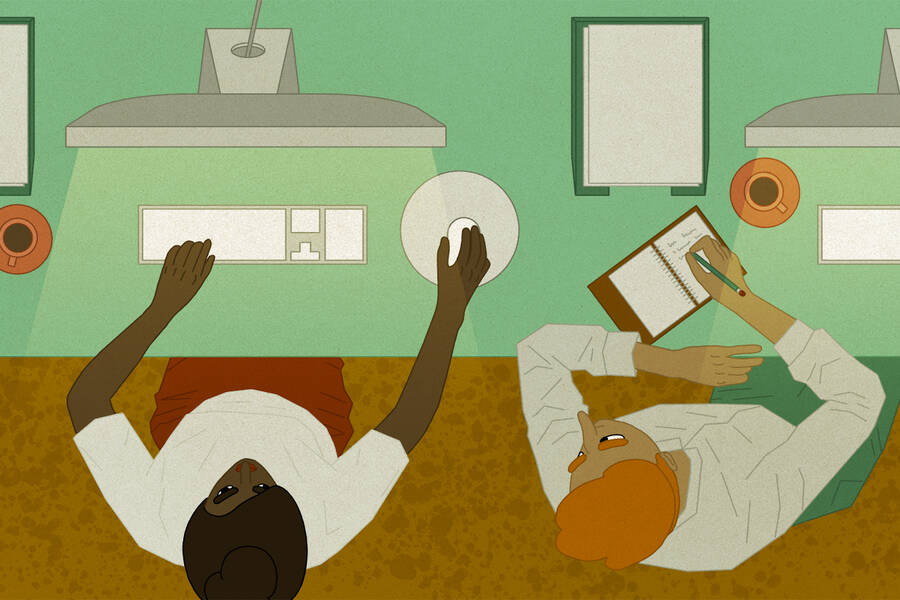Strategy Leadership Feb 3, 2020
How to Design Financial Incentives in Professions That Are Highly Territorial
A study of doctors shows that the best incentive schemes harness a desire to expand and protect professional turf.

Yevgenia Nayberg
If you want your employees to more consistently fill out tedious paperwork or be more attentive to customer needs, for example, the solution is usually quite simple: pay them more to do it.
But little is known about whether financial incentives like this work for professionals such as doctors, who have high autonomy and esoteric expertise, and often feel a dedication to “duty” over mere self-interest. Such professionals are infamously hard to manage by any means. They don’t want to be told how to do their jobs. And throwing more money at them isn’t likely to make them budge.
Kellogg assistant professor of management Jillian Chown witnessed this phenomenon firsthand in her former career as a healthcare operations consultant. “Often hospitals would point to the physicians as one of their bigger barriers to trying to improve how they do things,” she says. (No fewer than four researchers in the past decade have compared it to “herding cats.”)
So how could this be remedied? Chown wondered whether a subtler understanding of how these professionals do their jobs—particularly in areas that they feel territorial about—could reveal circumstances in which financial incentives can, in fact, motivate them. She knew the results might also apply to other professionals such as lawyers and architects, who often have a similar mentality toward their work.
She examined five years’ worth of data from the Canadian healthcare system and found that doctors would reliably perform more of a task or service if they were paid more for it—but only under certain conditions. Under different conditions, financial incentives had no effect.
Chown’s results suggest that organizations don’t have to accept conventional wisdom about the difficulty of directing professionals’ work. Instead, Chown says, “financial incentives can work—but you have to be mindful of how different features of professions are going to shape that responsiveness.”
A Different Way of Working
Most people generally think of professionals as white-collar workers who have a particular field of knowledge and expertise. But Chown hewed closer to what she calls the sociological definition, which describes how the job is done.
“The idea is that professionals need to ‘diagnose’ the situation that’s facing the client, then translate that problem into this abstract body of knowledge, figure out what it means, and then translate something back out of that knowledge into an actual solution to the client’s problem.”
”Professionals are always trying to jockey over tasks because they want to increase the number of tasks that they control.”
Another key aspect of this more technical definition of professionals is jurisdictional control: professionals exercise their problem-solving discretion by performing a collection of tasks that is more or less off-limits to other professions. Only architects are allowed to design skyscrapers, for example, and only neurosurgeons are allowed to excise brain tumors.
Usually through licensing or self-regulation, “professions are often being granted a monopoly over their services by society,” Chown says. “But, in exchange, they’re expected to have this normative orientation towards the service of society and to sort of act above self-interest.”
Chown’s interest in how to incentivize professionals—or “herd cats”—drew her to consider jurisdictional control as a starting point, because maintaining this control is one clear incentive that professionals do have.
This is especially true in certain professions (and the specialties within them) that have fuzzy jurisdictional borders, like architects and interior designers or physicians and nurse practitioners. In these circumstances, “professionals are always trying to jockey over tasks because they want to increase the number of tasks that they control,” she says.
A New Theory of Jurisdictional Control
Chown wondered if professionals’ desire for jurisdictional control might somehow influence how they respond to financial incentives.
A healthcare dataset from Canada offered an ideal way to explore possible connections. It included every medical procedure performed in the province of Ontario between 2005 and 2010, which amounted to more than 4,000 types of tasks conducted across 17 specialties.
But before Chown developed a specific hypothesis to investigate, she noticed something that changed her initial assumptions.
Jurisdictional control over professional tasks has been understood by researchers for decades as an all-or-nothing condition: for example, cardiologists were assumed to have jurisdictional control over ordering angiograms, while pediatricians do not have that control. Under this logic, any financial incentive attached to ordering angiograms should only
affect cardiologists, and not pediatricians.
But when Chown examined the data, she noticed that jurisdictional control over these tasks was much less binary.
“Some tasks were shared between multiple jurisdictions,” she says. “Cardiologists certainly do order angiograms, but pediatricians also order these types of tests because they’re dealing with children with heart issues.”
To more accurately characterize this nuance, Chown decided to categorize tasks along two dimensions: jurisdictional dominance and jurisdictional prominence.
Jurisdictional dominance is similar to control, but on a sliding scale, she explains. This concept captures the degree to which a task is split across professions or specialties. For example, cardiologists might have more jurisdictional dominance over the total volume of angiograms ordered, while pediatricians have less.
Chown hypothesized that the more dominance a profession has over a task, the more effective a financial incentive attached to it will be. Because professionals want to maintain their “monopoly” over tasks, as those tasks become more lucrative, they’ll perform them even more as a way of defending that newly valuable turf from adjacent professions or specialties.
Meanwhile, the second dimension Chown devised—jurisdictional prominence—describes how relevant or important a task is within a profession or specialty, as compared to other tasks. For example, an OB/GYN might spend 20 percent of her time performing prenatal assessments—a highly prominent task. Chown hypothesized that professionals would respond more to financial incentives attached to these tasks, compared to procedures with less prominence in their practice.
And, importantly, these two new dimensions can also intersect with each other: while almost all vasectomies in Ontario were performed by family doctors (high jurisdictional dominance), those doctors performed the procedure relatively infrequently compared to other procedures within their practice (low jurisdictional prominence).
Responding to Financial Incentives
Armed with these new distinctions, Chown analyzed the data to see how financial incentives affected physicians’ willingness to perform various procedures within their jurisdictions.
Doctors in Ontario are paid on a fee-for-service model based on rates defined by the government. This means that doctors’ incomes are directly influenced by the procedures they perform, but every doctor earns the same amount per procedure, regardless of their specialty. Fees for procedures are changed about every four years. So when the fee for a procedure went up—thus inducing a financial incentive to perform it—Chown could see how each specialty responded.
“If you’re trying to push professionals to do stuff around the periphery, you may have to make those tasks more salient, or attach a bigger incentive to actually induce a response.”
First, she found that doctors do respond to financial incentives, just like any other economically rational worker. For every 16 percent increase in the average fee of a procedure, the number of times physicians performed it rose by 4.6 percent.
This response might seem venal on its face, but Chown disagrees.
“Professionals responding to financial incentives doesn’t necessarily mean they’re hurting their patients or clients,” she says. “If the government says, ‘We really need to focus on smoking-cessation counseling, so let’s increase the incentive for physicians to provide this type of service,’ and they respond, then that’s great.”
But critically, the Canadian doctors didn’t simply follow the money. How they responded to financial incentives for certain tasks depended on the subtleties of jurisdictional prominence and dominance.
Increasing pay for a procedure with high jurisdictional prominence within a specialty—say, prenatal assessments, which obstetricians spend a lot of time performing—increased the number of those procedures by 29 percent, compared to the number of procedures done by specialists in which the task had an average level of prominence. But increasing a fee for a procedure with low prominence within a specialty—for example, drawing blood, which urologists spend less than 1 percent of their time doing—didn’t cause the doctors to perform more of it.
Chown says that this may be due to the fact that because these frequently performed tasks tend to capture physicians’ attention by default, they’re more likely to notice and respond to any incentive attached to those tasks as low-hanging fruit.
This suggests that organizations may be able to financially incentivize professionals to do more of what they already do often—but that dangling carrots around infrequently performed services won’t accomplish much, Chown says.
“If you’re trying to push professionals to do stuff around the periphery [of their usual practice], you may have to make those tasks more salient, or attach a bigger incentive to actually induce a response,” she says.
Capturing More Turf
To Chown’s surprise, she also found that attaching financial incentives to tasks with high jurisdictional dominance also had no effect.
Instead, and contrary to her hypothesis, doctors responded to financial incentives attached to tasks where they had low jurisdictional dominance.
For example, in 2006 Canada raised the fee for a certain kind of tendon-reconstruction surgery by 50 percent. Plastic surgeons had had high jurisdictional dominance over the procedure, performing 90 percent of them, while orthopedic surgeons had had low jurisdictional dominance, providing only 6 percent. Yet while the orthopedic surgeons increased their number of tendon surgeries by 11 percent following the fee increase, the plastic surgeons ignored the incentive.
Chown theorizes that this is actually the same professional territoriality at work but acting in the opposite direction. In other words, financial incentives are compelling physicians to “play offense” and go after scraps of newly valuable turf dominated by other specialties, rather than defend the jurisdictions they already dominate themselves.
Chown says that her findings show that, even with hard-to-manage professionals, money does talk—it’s just that the conversation is complicated.
“If organizations don’t understand that, then they may end up throwing money at stuff that professionals are never going to respond to,” she says. “Professionals are individuals, but their work is embedded in this broader system of tasks, which we call jurisdictions. And understanding how those jurisdictions work can actually make those organizational interventions more effective, hopefully.”



